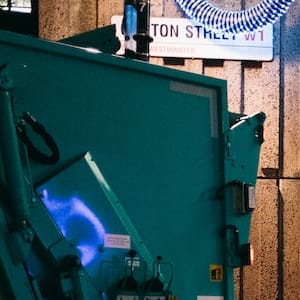throw a monkey wrench in the works: Idiom Meaning and Origin
What does ‘throw a monkey wrench in the works’ mean?
The idiom "throw a monkey wrench in the works" means to intentionally disrupt or sabotage a plan, project, or situation. It implies causing unexpected problems or obstacles that hinder progress or success.

Idiom Explorer
The idiom "work into the ground" means to exhaust or overwork someone to the point of physical or mental fatigue.
The idiom "upset the applecart" means to disrupt or spoil a carefully planned or established situation, often resulting in chaos or disorder.
The idiom "to no avail" means that someone's efforts or actions have not achieved the desired result or outcome.
The idiom *to hell in a handbasket* means to quickly and irreversibly deteriorate or go to ruin.
The idiom "tire fire" is used to describe a situation that is chaotic, out of control, or a complete disaster. It implies a sense of urgency and a need for immediate attention to resolve the problem. The term "tire fire" is often used metaphorically to refer to a situation that is incredibly difficult to handle and is causing a lot of trouble.
The idiom "tip the scales" means to have a decisive or significant influence on a situation or outcome, often by providing an advantage or causing a change in balance.
The idiom "tip the scale" means to have a decisive influence or to cause a significant change in a situation or outcome. It suggests the idea of adding weight to one side of a balance scale, disrupting the equilibrium.
The idiom "tie someone's hands" means to restrict or limit someone's ability to take action or make decisions, usually by imposing rules or regulations that inhibit their freedom to act.
The idiom "thumb on the scale" means to unfairly influence a situation or outcome in one's favor by cheating or manipulating the circumstances.
Curious Origins
The idiom “throw a monkey wrench in the works” has a clear and well-defined meaning. It is commonly used in American English to describe a situation where something unexpected or disruptive impedes the smooth progress of a plan, project, or process. To throw a monkey wrench literally means to deliberately introduce an obstacle or complication that hinders or derails the intended outcome.
The phrase “throw a monkey wrench in the works” is believed to have originated from the mechanical engineering industry, particularly in relation to industrial machinery and assembly lines. A monkey wrench, also known as an adjustable wrench, is a tool commonly used by mechanics to tighten or loosen nuts and bolts. In the early 1900s, it was not uncommon for disgruntled workers to sabotage or disrupt factory equipment in labor disputes or as acts of protest.
Throwing a monkey wrench into the moving parts of a machine would cause it to seize up, leading to significant delays and disruptions in production. This act of sabotage introduced an unexpected obstacle that hindered the smooth progress of the machinery and halted the intended outcome of the production line.
Over time, the metaphorical use of the idiom evolved beyond its literal association with sabotaging machinery. Today, it is frequently employed to describe any action or event that unexpectedly disrupts or hampers a smooth operation or plan. The phrase can be used in various contexts, ranging from everyday conversations to business meetings, political discussions, and even literary works.
The versatility of the idiom lies in its ability to vividly convey the imagery of a sudden and jarring obstruction to a well-planned course of action. It paints a picture of a wrench being thrown into the gears of a well-oiled machine, causing everything to come to a grinding halt.
While the idiom is primarily used in American English, it has gained recognition and usage in other English-speaking countries as well. The widespread popularity and understanding of the idiom can be attributed to its relatability and the vivid mental image it evokes. Anyone who has experienced the frustration of a disruption in their plans can understand the feeling of having a monkey wrench thrown into the works.
Additionally, the idiom's association with industrial machinery and labor disputes also contributes to its usage in discussions about politics, economics, and societal issues. It serves as a powerful metaphor to describe unexpected obstacles or complications that hinder progress, whether in the context of a political campaign, an economic policy, or a social movement.
It is worth noting that alternate versions of this idiom exist, but with slightly different wording. Some variations include “throw a spanner in the works” (used primarily in British English) and “put a monkey wrench in the machinery.” While these expressions convey a similar meaning and share the underlying concept of disruption, their specific origins and usage patterns may vary.
No matter the specific wording, the underlying concept remains the same - the introduction of an unexpected obstacle or complication that hinders the smooth progress of a plan, project, or process. Whether it's throwing a monkey wrench or a spanner into the works, the result is the same - the disruption of a well-planned course of action.
The enduring relevance and popularity of the idiom “throw a monkey wrench in the works” can be attributed to its ability to effectively communicate the frustration and disruption caused by unexpected obstacles. Its longevity and continued usage highlight its enduring relevance in everyday conversations, professional settings, and creative works.
So the next time you encounter an unexpected obstacle that derails your plans, remember the idiom “throw a monkey wrench in the works.” It's a vivid and relatable way to describe the frustration and disruption caused by unexpected obstacles. Whether you're dealing with a labor dispute on an assembly line or a sudden change of plans in your personal life, this idiom captures the essence of the situation perfectly.
Throwing a monkey wrench into the works may bring things to a grinding halt, just like throwing a spanner in the works or putting an ant into a sty.
Example usage
Examples of how the idiom "throw a monkey wrench in the works" can be used in a sentence:
- He decided to quit his job right before the project deadline, throwing a monkey wrench in the works.
- The unexpected power outage threw a monkey wrench in the works of their carefully planned event.
- Her suggestion to change the entire strategy at the last minute threw a monkey wrench in the works of the marketing campaign.
More "Obstacles" idioms



